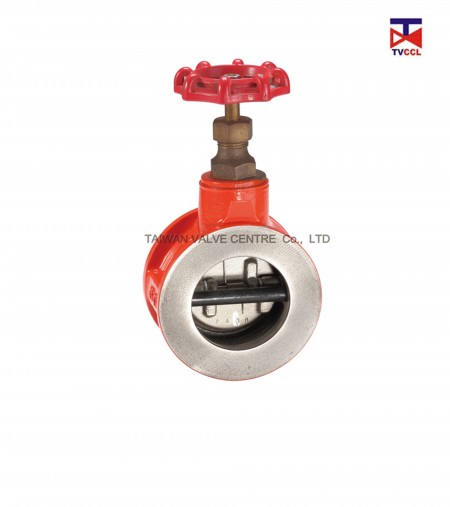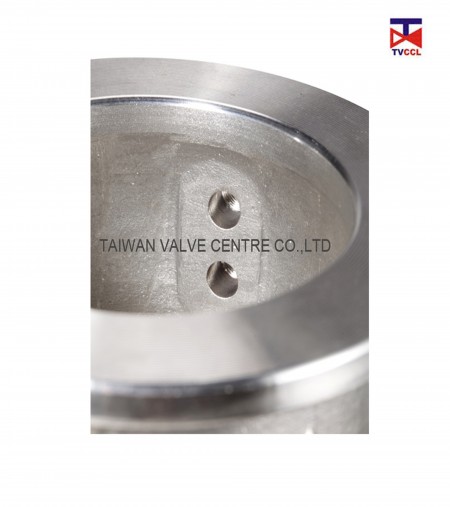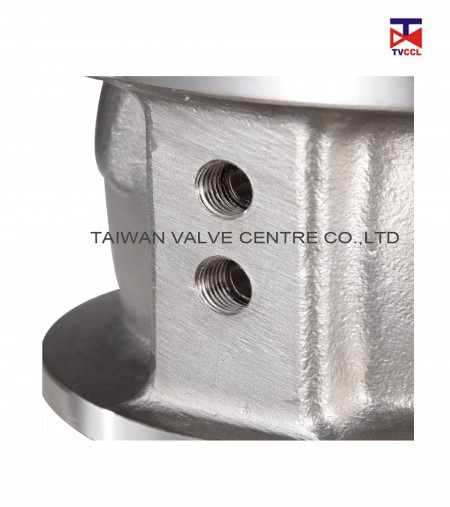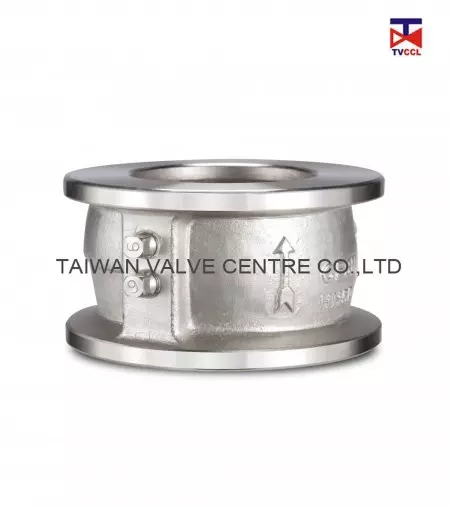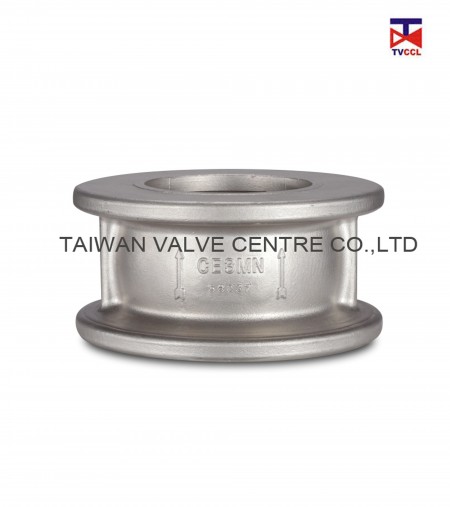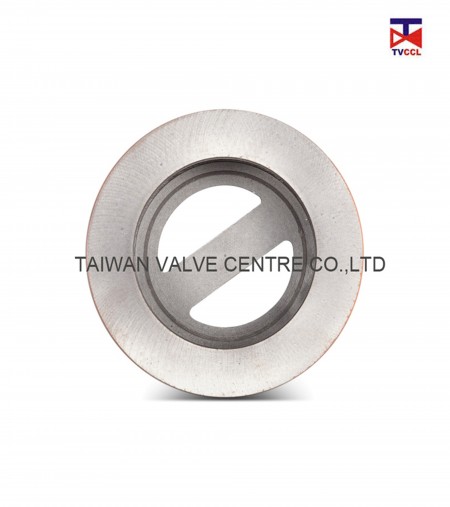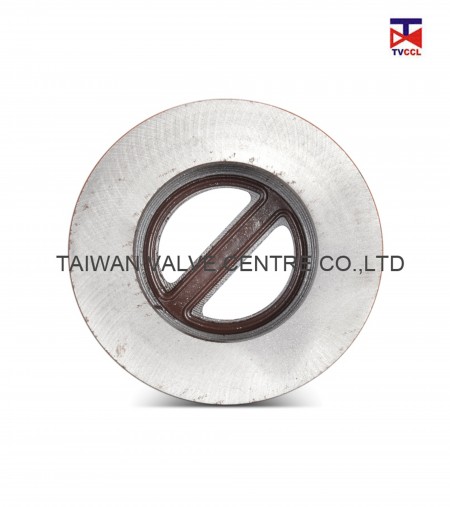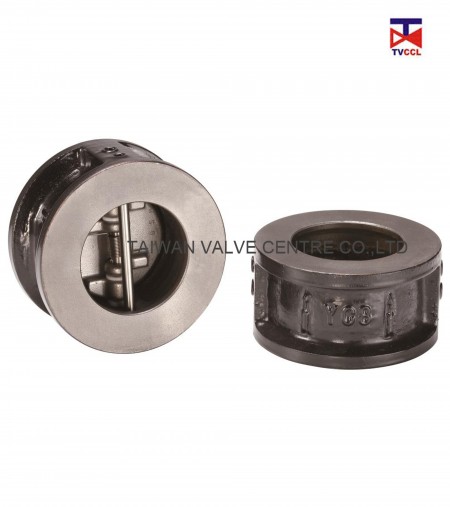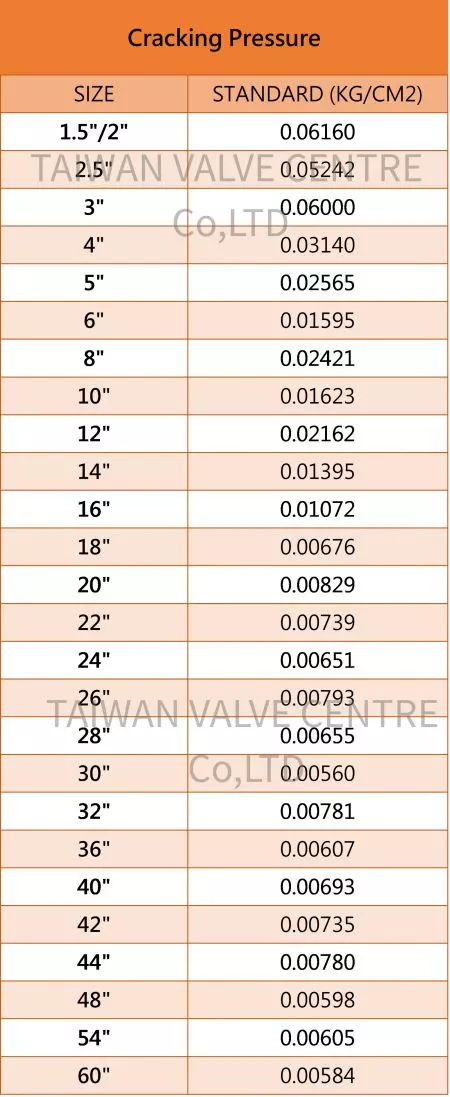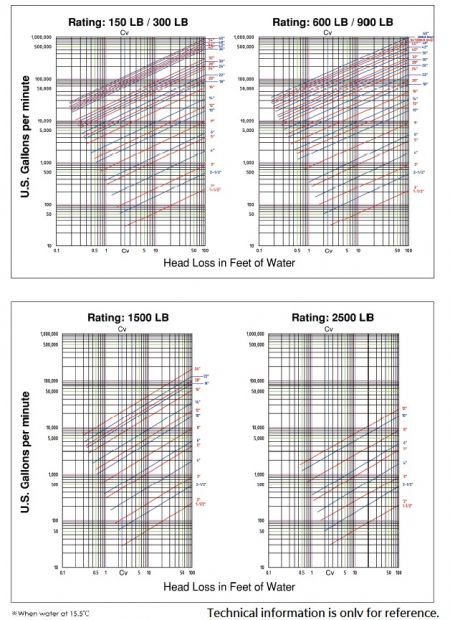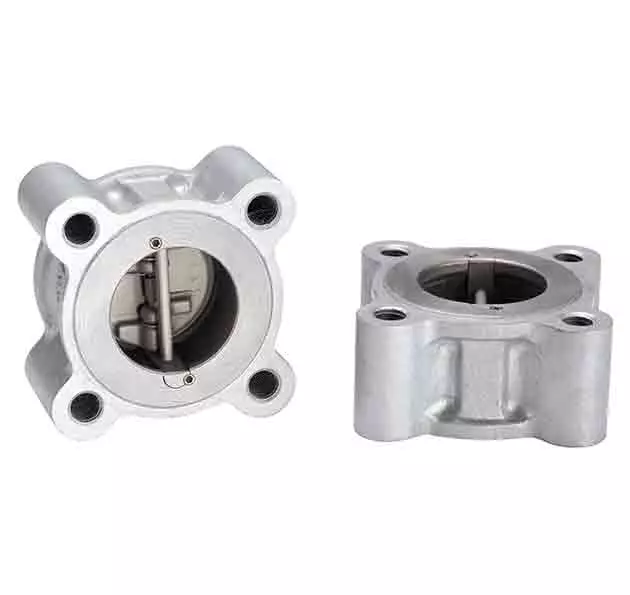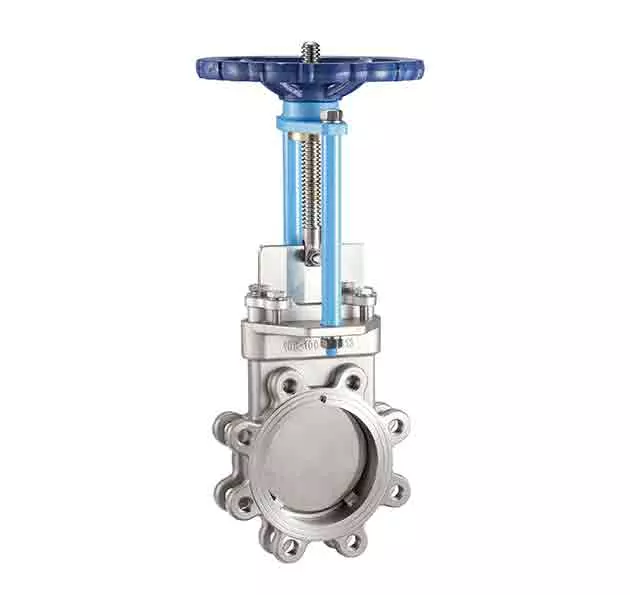Dual Plate By Pass Type Check Valve
TC2
Bypass dual check valve, reducing valve, backflow check valve
By-pass valves are generally used for three basic reasons:
To allow the pipeline differential pressure to be balanced, lowering the torque requirement of the valve and permit one-man operation.
With the pump closed and the by-pass open, a continual flow is allowed, avoiding possible stagnation.
Delayed filling of pipelines.
The bypass valve produced by TVCCL is a dual plate wafer type check valve with a hand-wheel to adjust the water flow and achieve dredge effect. It is very simple to use the hand-wheel to control valve to open and close. The installation method is the same as the dual plate wafer type check valve. The only difference is the hand-wheel. The advantage of using the hand-wheel to control the pressure difference is that without external power, and the pressure of the system itself is actuated, which effectively improves the operational safety and more reliable than the conventional electric control valve. Also, the price of the bypass valve is lower than the electric control valve.
Dual disc check valves are commonly installed in applications that backflow would cause an issue. However, since they are non return valves, they are a cheap, effective, and easy solution to solve a potential issue.
All place install check valve while Pipe have control valve or pump. If fluid have to back upstream after it.
Under some situation which need to stop returning also backflow, at this point it can backflow through the bypass which on check valve, to regulating too much flow in a pipeline by backflow. E.g. Pool on roof.
Body with full rubber lined can effectively reduce disc's leakage probability for the corrosion of seawater. In addition, body can choose CI or DI material to decrease cost.
Back-up Line for Uses Such as Replacement of Equipment.
Features
- By pass check valve can be fluid control and decompression,Especially if replacing an existing valve to avoid pipe modifications.
- Bypass check valve can be used as a regulator when replacing equipment.
- Bypass check valve increases safety and saves money with handwheel than the electric operator.
- Retail acceptable.
- Beautifully packaged.
- Customized special valve.
Dual Plate Check Valve Installation Guide:
When installing a check valve, it can be used in both indoor and outdoor environments. However, if the medium is corrosive or the surroundings are prone to rust, it is essential to select a valve material combination that matches the conditions to ensure durability and safety. For special operating conditions, it is recommended to consult TVCCL’s technical team for professional advice.
Before installation, all debris, oxidation scale, and solid impurities inside the pipeline should be thoroughly removed to prevent interference with the valve’s operation. During installation, the flow direction of the medium must align with the arrow marked on the valve body. The piping should be aligned at the front and rear centers, with flange interfaces kept parallel and bolts evenly tightened. Special attention should be paid to the distance between the check valve and the pump, which should be six to eight times the valve size to ensure stable system performance.
For routine maintenance, regular inspections should be conducted to check for leakage, abnormal noise, or vibration. In addition, the valve should be periodically examined for signs of corrosion, jamming, or other irregularities. Necessary cleaning, dust removal, and residue treatment should be performed to maintain proper equipment operation and extend its service life.
Specification
- Size: 2" ~ 24" (DN50 - DN1500)
- Pressure Rating For ASME: 125# ~ 150# Suit For ASME / MSS / API Flange
- Pressure Rating For JIS: 10K Suit For JIS Flange
- Material:CI,DI
- Designed in accordance with API 594
- (Other flange connection please contact Taiwan Valves Centre Co., Ltd.)
- *Technical information is only for reference. Taiwan Valves Centre Co., Ltd. reserves the right to change without previous notice.
SELECTION GUIDE
1. Clarify Application Requirements and System Conditions
Begin by thoroughly assessing the environment in which the valve will operate. Key considerations include:
• Type of fluid — Is the medium water, oil, gas, slurry, or a corrosive chemical?
• Operating parameters — What are the system’s maximum pressure and temperature?
• Flow behavior — Is there a risk of sudden flow reversal or water hammer?
• Space limitations — Is the piping layout compact or spacious?
These factors help identify the most suitable valve materials and configurations for your system.
2. Select Materials Based on Fluid and Environment
The valve’s body and internal components must withstand corrosion and wear caused by both the fluid and the surrounding conditions. Common material choices include:
• Stainless steel — Excellent for corrosive or sanitary applications.
• Carbon steel or cast iron — Suitable for general-purpose use with non-aggressive media.
• PVC or engineered polymers — Ideal for low-pressure, non-corrosive systems.
Avoid incompatible combinations—such as using brass or mild steel with aggressive chemicals—as this may result in premature failure.
3. Choose the Correct Size and Pressure Rating
Valve sizing should align with the pipe diameter and expected flow rate:
• Proper sizing minimizes pressure drop and prevents turbulence.
• Ensure the valve’s pressure and temperature ratings exceed system requirements to maintain safety and reliability.
4. Evaluate Valve Dynamics and Performance Characteristics
Different wafer check valve designs offer distinct advantages depending on system demands:
• Spring-loaded or dual-plate wafer valves — Provide quick, silent closure to prevent water hammer in high-cycle operations.
• Standard single-plate models — Adequate for slow, steady flow in simpler systems
Seat Material Options for Dual Plate Check Valves
The seat of a dual plate check valve is available in a wide range of materials to meet various media properties, temperature ranges, and pressure conditions. Selecting the right seat material is essential to ensure reliable sealing performance, extended service life, and stable system operation.
Soft Seat Options:
Soft-seated designs provide excellent sealing performance and are typically made from rubber materials such as EPDM, NBR, or FKM (Viton®).
EPDM – Ideal for cooling water, potable water, and general water treatment applications.
NBR – Suitable for oils, air, and other neutral media.
FKM (Viton) – Offers superior resistance to high temperatures and aggressive chemicals, making it ideal for chemical and petrochemical industries.
Metal Seat Options:
For high-temperature, high-pressure, or abrasive conditions, metal seats are recommended to ensure enhanced durability and wear resistance.
Metal seats can be manufactured from the same material as the valve body or from stainless steels such as SS304, SS316, SS410, or hard alloys like Stellite 6. The allowable leakage rate for metal seats varies depending on valve size.
For any special rubber material requirements, please feel free to contact us.

HEAD LOSS
Head loss refers to the loss of a fluid’s total energy (or pressure) as it flows through pipelines or valves, caused by factors such as friction, turbulence, changes in flow direction, and resistance within the flow path. In a dual-plate check valve, head loss is the pressure drop that occurs when the fluid passes through the valve plates and internal structure.
The smaller the head loss, the lower the resistance the fluid encounters when passing through the valve, the higher the flow efficiency, and the less energy is dissipated. This reduces the system’s pumping energy consumption and improves overall operational efficiency. Conversely, larger head loss indicates greater flow resistance and requires the pump to expend more power to maintain the desired flow rate. Therefore, analyzing head loss data is an important step in valve selection to ensure system efficiency, pressure control, and economic performance.
Dual Plate Wafer Type Check Valve Operation
When fluid flows in the forward direction, the pressure of the medium pushes the two plates open around the hinge pin, allowing smooth passage with minimal resistance. As the flow velocity decreases, the torsion springs automatically begin to act, gently returning the plates toward the body seats. This design minimizes the distance and time required for closure.
When flow reversal occurs, the plates are already near the seat, enabling the valve to close quickly and securely. This rapid dynamic response significantly reduces the water hammer effect, ensuring quiet, non-slam performance and protecting the system from pressure shock and vibration.
Advantages of Dual Plate Check Valves
Dual plate check valves offer several advantages that make them ideal for modern piping systems. Their compact and lightweight wafer design allows easy installation between flanges, saving both space and weight. The two spring-loaded plates close rapidly when flow decreases, effectively preventing backflow and minimizing water hammer.
Because of their simple structure and few internal components, dual plate check valves require minimal maintenance and provide reliable automatic operation without external power or manual control. They are available in a variety of materials and configurations, making them suitable for water treatment, HVAC, marine, power generation, and industrial fluid systems.
Functions of Dual Plate Check Valves
The primary function of a dual plate check valve is to prevent backflow and ensure that fluid flows in one direction only. Its two spring-loaded plates respond quickly to changes in flow, closing rapidly when flow reversal occurs to protect pumps, compressors, and other equipment from damage.
In addition to backflow prevention, dual plate check valves help maintain system pressure stability, minimize water hammer through non-slam operation, and improve overall energy efficiency. Their compact wafer-type design allows for easy installation and reliable performance across water treatment, HVAC, marine, power generation, and industrial pipeline systems.




Applications
- By pass check valve is suitable for waterworks.
- If the fluid passing through the check valve need to returned to upstream, a bypass check valve will be a good choice.
- The bypass valve can prevent oil from entering the fuel system, guarantee the normal lubrication of the entire engine.
- Bypass check valve is also used in central heating systems to ensure that the heat sink is not over pressured or emptied
- Check valves are available for applications with control valves or pumps. e.g. check valve or BY pass check valve.
- Bypass valves are basically there to vent pressure, it can be substituted for slow closure type valve.
More Knowledge about TVCCL valve:
Bypass valves are typically used in two situations as follows:
1. Replace the equipment, the bypass valve is not only to maintain the flow of the medium but also has a certain fluid control function. Therefore, it can be used as a substitute for pressure reducing valve and steam trap. When the equipment is replaced, the bypass valve can be used as a backup valve. When the equipment such as pressure reducing valve and steam trap is damaged or needs to be replaced and repaired, they are isolated. Or close the main pipe and open the bypass valve to keep the device running.
2. Strengthening function, the bypass valve can be used as a pressure reducing valve and a steam trap to enhance the hydrophobic performance.
More Knowledge about dual plate check valve:
Bypass valve has adjustment function. Not only adjust pressure between upstream and downstream, has hydrophobic capability.Bypass valve, also known as the bypass differential pressure valve, has the function of regulating the differential pressure between the upstream and downstream and can be hydrophobic. Bypass valve automatically adjusts according to the pressure change of the medium and balances the pressure difference between the medium in and out of the channel, which helps to stabilize the pipeline operation. For example, pressure reducing valves, control valves and traps are usually equipped with bypass pipes. The valve installed on the bypass pipe is called a bypass valve. Bypass valve refers to a valve that is mounted on a bypass pipe but does not specifically refer to the valve type and construction.
- Files Download
-
Dual Plate Wafer Style Check Valve Installation and Maintenance Instructions
Installation and Maintenance Instructions for dual plate check valve
Download - FAQ
-
Q.What Is Check Valve?
TVCCL Check Valve is a dual plate check valve that conforms to API 594. TVCCL is known as one of the leading manufacturers of Valve in Taiwan since we established. A...
Q. How Do Install Double Disc Check Valve In Pipe?
Taiwan Valve Centre Co.,Ltd. is the professional dual check valve manufacturers in the Taiwan. This information concerning the installation and operation...
Q. What Kind Of Material TVCCL Stock For Dual Check Valve?
Materials Stocked for Dual Plate Check Valve by TVCCL TVCCL, a pioneer in valve manufacturing, has been at the forefront of the industry since 1998. Our expertise...
Dual Plate By Pass Type Check Valve - Bypass dual check valve, reducing valve, backflow check valve | Made in Taiwan Dual Plate Check Valves Manufacturer | Taiwan Valve Centre Co., Ltd.
Located in Taiwan since 1998, Taiwan Valve Centre Co., Ltd. has been a dual plate check valve manufacturer with all the valves sold to 1,500 clients in 80 countries worldwide. Their main valve products, including Dual Plate By Pass Type Check Valve, dual plate check valves, dual plate full lining type, retainerless check valves, bypass check valves, short and long wafer check valves and spring wafer type for industries, such as oil, shipbuilding, seawater desalination, cooling system and nuclear.
TVCCL has a competitive pricing, reliable quality product and excellent after-sales support, well-down packing. We have received good reputation as being a well-known supplier in supplying reliable quality and competitive price check valves from customers. 20 years of experiences in producing dual plate check valve, excellent after-sales support, OEM / ODM, oil industry, shipbuilding, seawater desalination, cooling system, nuclear industry.
TVCCL, TAIWAN VALVE has been offering customers high-quality and durable industrial check valves for any applications since 1998, both with advanced technology and 25 years of experience, TVCCL, TAIWAN VALVE ensures each customer's demands are met.

